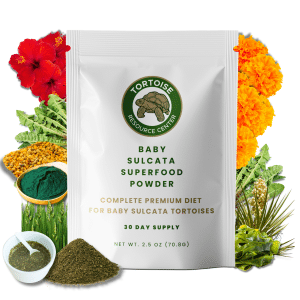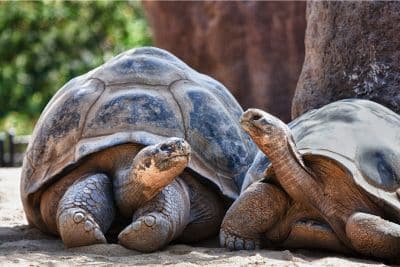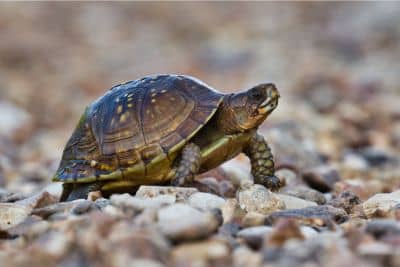Most tortoises are important members of the habitats they call home, but some have an impact that is disproportionate with their population. In other words, they have a larger influence on the habitat than you’d expect, given the number of individuals present.
These types of animals are called keystone species, and gopher tortoises (Gopherus polyphemus) are one of the world’s best examples. Many (if not most) keystone species are predators, who influence their habitats by consuming a variety of prey. But gopher tortoise are herbivores who serve their habitats in a different way: They dig long tunnels that are used by a variety of their neighboring species.
In fact, scientists estimate that more than 350 different species use gopher tortoise burrows. Some only move in once the tortoises move out, but others are happy to share a burrow with a sleeping tortoise.
Unfortunately, these tortoises are under threat in the wild, which puts the entire ecosystems in which they live in jeopardy. Accordingly, these tortoises are protected and rarely kept as pets. Nevertheless, they’re certainly interesting, and I’ll explain the basic facts and stats about them below.
Habitat and Range
Gopher tortoises are native to portions of the southeastern United States coastal plain. In total, they’re found in parts of Florida, Georgia, Alabama, Mississippi, and Louisiana. However, most of their lies within the states of Florida, Georgia, and Alabama.
Within this range, gopher tortoises are found in several different types of habitats, though they all share a number of similarities. For example, most habitats harboring gopher tortoises are at least partially open; they all have low-growing herbaceous plants; and they all have sandy soils, which enable the animals to excavate burrows.
Physical Traits
While gopher tortoises are certainly interesting and noteworthy in many ways, their physical traits are relatively typical and similar to those of most other medium-sized tortoise species.
Size
Some gopher tortoises remain relatively small, and measure about 6 to 8 inches in length. However, many others grow much larger than this, with the largest individuals measuring 16 inches or so. Most gopher tortoises weigh between 6 and 10 pounds, but large specimens may weigh 13 pounds or more.
Markings and Morphology
At the time of hatching, many gopher tortoises have a yellow to tan ground color, and the individual scutes of their carapaces often have dark brown to black borders. As they age, gopher tortoises tend to become more-or-less uni-colored, though that color may range from tan to nearly black.
In terms of build, gopher tortoises tend to be slightly elongate, with slightly flattened shells. These are likely adaptations which make it easier for them to crawl in burrows.
Diet
Unlike some tortoises, who have relatively specialized diets, gopher tortoises are generalists, who consume a very broad assortment of plant species, ranging from pine needles to grass to fruits to wildflowers. They likely focus on the species that are common in their specific area.
Gopher tortoises have been documented consuming dead animals, invertebrates, and feces on occasion, but these items don’t significantly contribute to their overall diet.
In captivity, gopher tortoises typically thrive on a varied diet including standard tortoise fare, such as leafy greens, dandelions, wild grasses, and assorted fruit.
Behavior
Gopher tortoises certainly are appropriately named, as they’re incredibly skilled diggers. While many tortoises dig burrows or tunnels, gophers excel at the task. Many of their burrows measure 15 to 20 feet in length and penetrate below ground more than 5 feet, while especially long examples have been found measuring nearly 50 feet long!

In fact, gopher tortoises often dig several tunnels they’ll use at different times. In total, gopher tortoises spend most of their time inside these tunnels. Researchers have found that some tortoises will spend as much as 80% of their time inside their tunnels, which helps the animals avoid temperature extremes, dehydration, and predators.
Gopher tortoises may breed at any time from February to September, but breeding activity peaks in the early summer. Clutches may consist of as many as 25 eggs, and they’re usually deposited in close proximity to one of the tortoise’s existing tunnels.
Are You Starving Your Tortoise?
Save 10% on premium tortoise food and supplements from Tortoise Resource Center on Amazon now using code BUYNOWGET10

Sulcata Vitamin & Mineral Topper Supplement
30-Day Supply | 2 oz (56 g)
$24.99

Baby Sulcata Tortoise Superfood Powder
30-Day Supply | 2.5 oz (70.8 g) Bag
$24.99
Do Gopher Tortoises Make Good Pets?
Gopher tortoises may make good pets for some keepers, but it doesn’t really matter: They’re illegal to keep as pets in the United States, as they’re protected by federal law. Some states also have laws that prohibit their possession or sale. Occasionally, the federal government issues temporary permits that enable private individuals to care for these animals, but that’s generally only for those who’re involved with rehabilitation programs.
Even if you could legally keep a gopher tortoise as a pet, it’d be tricky to do so, given the species’ habit of constructing very long tunnels. They’d only be suitable for outdoor maintenance, and you’d have to go to great lengths to allow your pet to create a tunnel, while still ensuring that your pet doesn’t tunnel outside of the boundaries of your property.
These issues aside, gopher tortoises are usually undemanding captives for zoos and other facilities, as they’re generally hardy, easy to feed, and personable.

Stats at a Glance
Even though gopher tortoises aren’t available to typical tortoise keepers, they’re interesting animals that you may want to know more about. To that end, here are some important statistics about these incredible animals:
- Typical Hatchling Length: 2.5 inches
- Typical Hatchling Weight: Approximately 50 grams
- Average Adult Length: 6 to 16 inches
- Average Adult Weight: 6 to 10 pounds
- Average Annual Fecundity: 1 to 25 eggs, deposited in a single clutch.
- Recommended Enclosure Size: 30 to 50 square feet, with plenty of room to accommodate their tunnels.
- Typical Lifespan: Unknown, but they’re likely capable of living for at least 40 years, and potentially longer.
Citations
- Conservation Evidence — A hatchling gopher tortoise (Gopherus polyphemus) care protocol for experimental research and head-starting programs
- Southeast Gap Analysis Project – Gopher Tortoise (PDF)
- Outdoor Alabama – Gopher Tortoise Facts


